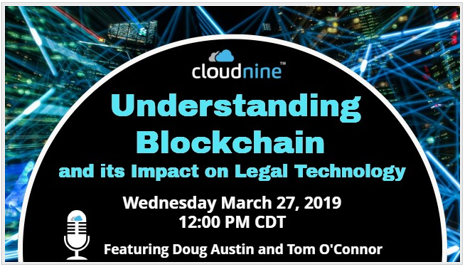Years ago, there was a TV commercial for chili where the spokesman said “Neighbors, how long has it been since you’ve had a big thick steaming bowl of Wolf brand chili? Well, that’s too long.” It’s been too long since we’ve provided an update of M&A+I activities in eDiscovery, so let’s fix that. Also, I’ve had a lot of questions recently about what’s going on with the products that CloudNine acquired a year ago, so let’s provide an update on that as well.
As always, the best resource for tracking eDiscovery Mergers, Acquisitions, and Investments is Rob Robinson’s ComplexDiscovery site – after all, Rob via ComplexDiscovery has noted more than 375 M&A+I events between November 2001 and today.
Rob’s latest update is for the just completed Q1 of 2019. His review was through March 22, but I’m not aware of any significant M&A+I announcements since then, so it’s probably good for the entire Q1. Based on that, Rob notes five key findings for Q1 2019:
- There have been at least 14 M&A+I events in the eDiscovery ecosystem during Q1 2019.
- January was the most active month in Q1 2019 for M&A+I events with at least 11 total events. This is the most active January since the inception of eDiscovery ecosystem M&A+I pattern tracking in November 2001.
- March was the least active month in Q1 2019 for M&A+I events with two known events.
- The investment pulse rate for the three months of Q1 2019 appears to be higher than annual Q1 investment patterns. Q1 2019 is tied with Q1 2012 for the most active Q1 since the inception of eDiscovery ecosystem M&A+I pattern tracking in November 2001.
- Q1 2019 investment pulse rate appears to be slightly higher than the investment pulse rate during the same period in Q1 2018.
As usual, Rob also provides some charts to reflect the activity graphically: for 2019 (so far), a per month history since Rob started tracking in November 2001 (January is the most active month historically) and activity on a per year basis, which does a great job of reflecting how many more transactions have occurred in recent years than in the past. To wit: Q1 2019’s 16 transactions are more than all but one year from 2001 to 2009.
Interesting stuff. BTW, speaking of ComplexDiscovery, Rob yesterday launched his Spring 2019 eDiscovery Business Confidence Survey. As usual, the survey only takes about a minute or two to complete, so drop in and complete it if you have a minute (or two). Rob says the survey will close around mid-April, so do it sooner rather than later to get your feedback included.
Anyway, speaking of acquisitions, it’s hard to believe that it was a year ago last week that CloudNine acquired the eDiscovery product lines from LexisNexis. When I was at the University of Florida E-Discovery Conference a couple of weeks ago, several people asked me what was going on with the LAW, Concordance and EDA (now renamed Explore) product lines that we acquired. So, let me address each of those (and our own CloudNine Review platform) with a brief update.
Normally, when I start to talk about CloudNine products, I preface it with a “shameless plug warning!”. So, consider yourself warned. And, if you want to complain that this blog post isn’t educational, remember that I started it with some interesting eDiscovery M&A+I info. ;o)
LAW: LAW PreDiscovery is now known as CloudNine LAW and we just announced a new 7.1 release yesterday (unlike yesterday’s blog post, this was no April Fool’s Day joke). This is our third release since the acquisition and our second in just the last two months! The cornerstone of our 7.0 release back at the end of January was our new multi-core, multi-threaded Turbo Import ingestion engine to process and load data considerably faster than the traditional ED Loader module – with the 7.1 release now officially out, we have improved the ingestion speeds up to 12x faster compared to ED Loader. Imagine having a super large PST file that used to take over 24 hours to process – now it can be processed in just over 2 hours. Talk about saving time!
We have implemented several other new features and fixes over the past year and have partnered with Compiled to provide an automated link between LAW and Relativity (announced back in January). And, we have several additional exciting features coming out over the next couple of quarters (targeting two more releases before Q4).
Explore: Also referenced in yesterday’s announcement, Explore has also seen some speed improvements and other feature additions over three releases since acquisition. Explore has a unique index-in-place approach that also supports multi-threaded processing of large container files and the ability to distribute processing over multiple machines. We recently partnered with a third party to conduct benchmarking of Explore and were able to index a terabyte (TB) of data in 7 hours, 15 minutes! So, Explore is a terrific product for indexing and searching large collections of data quickly to support early data assessment, compliance on investigation needs and we have talked with a number of customers who are impressed with its speed and capabilities.
Concordance: Many people have asked what we’ve been doing with Concordance since we acquired it and we have had three software releases for Concordance as well since we acquired it. We are currently working on brand new viewer technology to improve the experience for users of both the Concordance image viewer (e.g., support of color images, search within image) and Concordance native viewer (e.g., speed of image retrieval) that we expect to roll out around mid-year. And, we are finalizing a link with Hot Neuron’s Clustify product to enable Concordance users to perform conceptual clustering, near dupe identification, email thread identification and predictive coding!
CloudNine Review: Our flagship CloudNine review platform is now known as CloudNine Review and we are also working on a number of new features and capabilities with that product as well. We recently released a brand new managed review module within CloudNine Review and are currently working on several updates and improvements to the user interface overall – to provide a cleaner and even more intuitive look and feel.
There’s a lot more to say about each of these products – for example, we have doubled the size of our teams developing, testing, supporting and training on the products since acquisition – but, I try to keep our blog posts reasonably short. Feel free to drop me a line if you want to know more.
So, what do you think? Are investments in eDiscovery companies on the rise? Please share any comments you might have or if you’d like to know more about a particular topic.

Sponsor: This blog is sponsored by CloudNine, which is a data and legal discovery technology company with proven expertise in simplifying and automating the discovery of data for audits, investigations, and litigation. Used by legal and business customers worldwide including more than 50 of the top 250 Am Law firms and many of the world’s leading corporations, CloudNine’s eDiscovery automation software and services help customers gain insight and intelligence on electronic data.
Disclaimer: The views represented herein are exclusively the views of the author, and do not necessarily represent the views held by CloudNine. eDiscovery Daily is made available by CloudNine solely for educational purposes to provide general information about general eDiscovery principles and not to provide specific legal advice applicable to any particular circumstance. eDiscovery Daily should not be used as a substitute for competent legal advice from a lawyer you have retained and who has agreed to represent you.








